The advantages and impediments in the technology of the historical instrument
(V3cT2)
As suggested in the above sections, the two crucial conditions of acquiring advanced violin technique are a) starting at an early age and b) having competent guidance. These conditions further imply a particularly structured learning process. At an early age, the student will more easily acquire technical skills, embodying naturally the complicated biomechanical principles, without much thinking, just like when learning a language. The competent guidance ensures that the student will avoid bad habits, and, being the rational agent, the teacher will also create a pedagogically sound progression from simple to more complicated exercises.
Historical surveys of violin playing imply an evolutionary trajectory of technical accomplishments (Boyden, 1990). According to this view Arcangelo Corelli should be aw-struck when encountering Mozart’s violin concertos. Similarly, Mozart would hardly cope with Viotti’s concertos. And what about Paganini? Did he not bring technique to the furthest limits? Does he not still hold the world record for playing the fastest and most awkward double-stop passages? And yet, witnessing violin virtuosos such as Oistrach, Stern, Zukerman, Perlman, Vengerov, Kavakos, etc., mastering the 'impossible' concertos of Brahms, Tchaikovsky, Berg, Shostakovich, Prokofiev, Stravinsky, etc., it seems that the implied evolution has not yet reached its limits.
So where do the HIP performers fit in to all this? Do players like Sigiswald Kuijken, Reinhard Goebel, Andrew Manze, Fabio Biondi, Rachel Podger, Dmitry Sinkovsky, Fredrik From, etc. contribute to the evolutionary line? Or do they rather deviate from the traditionalist’s line, constructing an alternative trajectory 'back to the future', based on historical information?
While the open animosity between traditional and historically informed violinists has long subsided (with the exception of Mr. Zukerman), there is still a considerable gap between the two practices. While the ‘modern’ orchestras flexibly embrace elements of historical performance practice, inviting baroque experts as soloists or conductors, and while the younger generation of soloists does incorporate some features of the historical style, there are many differences in the technology and aesthetics of sound production. In the following section I will review some possible grounds for these differences. By unpacking some remaining prejudices in the two camps, I will attempt to reveal the principal grounds for these differences, based on the differing kinaesthetic affordances of playing baroque and modern violins.
Starting early and having competent guidance was not invented by the pedagogy of the 20th century, but is already implied in Leopold Mozart’s violin school, when he describes how violin skills must be embodied to the extent of ‘becoming a second nature’ (Mozart, 1756/1985, p. 61). Thus, embodying the sound was as crucial for a violinist in the 18th century as it is today. The incorporation of this tradition by a student is not only a mechanical learning process. The student reinvents the tradition in the act of embodiment. The important factor in the process of learning is the teacher. The ways in which the skills are transferred to the student are not based on 'information' how-to-do-it, but guidance through continuous exercises designed so that the student may embody the skills naturally as if ‘without thinking’. The main communication between the teacher (the tradition) and the student is not verbal. By examples, inspiration, and guidance, the student starts to feel the sound emanating from the proper technical movements applied to the instrument. The aesthetics of a ‘good sound’ is thus undividable from the technology of its production. Making a good sound is second nature for a violinist. Good sound is a sound properly produced. For a Soundist virtuoso – having a synonymic understanding of the terms sound, technique, and music – it is inconceivable for any of these features to be undermined separately without the whole falling apart.
The HIP movement took rounds in questioning some, or all three grounds of traditional pedagogy and performance. Traditional musical interpretation is inadequate, because it neglects the intentions and the historical context of the composer. The sound is inappropriate because it is not produced on historical instruments. The performance techniques are inadequate, because they neglect historical performance practice (Kivy, 1995).
The responses were vehement, and it is no wonder that animosity was raised between the traditionalists and the HIP movement. The traditionalists dismissed HIP as ‘sounding bad’; being puritans of historical rules without having sufficient evidence; lacking the basic principles of technique (Sherman, 1997). And fair enough, the pioneers of the HIP movement were in a paradoxical situation. They did not embody the technical principles of their historical instruments, and, being pioneers, they had no guidance in the form of a 'historically' competent teacher. Additionally, HIP performers grew up and embodied the traditional values of their earlier studies, the very embodied values that they now had to refute. The mistrust of employing their own bodies ‘as they were’ was in fact grounded in the fear of succumbing to the tradition again. Therefore, HIP constructs new performance techniques based on historical information. Experimental reconstruction of historical performance practice brings a new sound ideal, maybe not as resonant, brilliant, and round as the traditional sound, but complying with the new criterion that seemed to matter: it was ‘authentic’.
While the changes occurring in the continuous trajectory of the tradition are subtle, often coinciding with a new generation of players, the HIP revolution was sudden and had significant consequences for HIP practitioners. The design of historical instruments and how they are held, the shape and the length of the baroque bow, the use of gut strings, all caused a complete disruption to their practice. Due to a lack of guidance and a distrust of their own embodied habits, HIP violinists invented a new set of playing techniques, which amalgamated existing historical findings with intuitive inventions.
What then are the kinaesthetic implications of baroque violin technique? Are there any features of the interaction with baroque instrument that trigger specific movements, with different aesthetic aims? How does it connect to bowing techniques, when we say that a modern violin sings, while in baroque music it dances and speaks? Before I examine the baroque bow action, let us review the bow action with a traditional modern bow.
There is a large vocabulary of bow-strokes categorised by their relation to the middle of the bow. This central axis serves as a reference to the sensation of balance, weight and speed of the bow. Galamian distinguishes three stages of the whole-bow stroke: the square, triangle, and straight positions (Galamian, 1962).
Setting a modern bow on the string in the middle of the bow creates a square angel between the bow, forearm and upper arm.
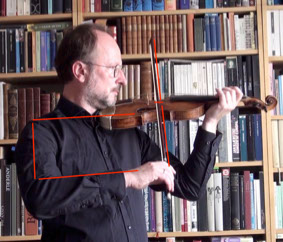
Ex. 1 'Square position': Setting the modern bow on the string in the middle of the bow creates a square between arm, bow and instrument.
Drawing the bow from the middle to the tip, the elbow joint opens and straightens out, as if pushing the bow ‘away’ from the body. A reversed action is applied when the bow is drawn from the tip to the middle. The elbow joint is closing, as if pulling the bow closer to the body, bringing the forearm back into the square position when the middle of the bow is reached.

Ex. 2 Drawing the bow from the middle to the tip, the elbow joint opens and pushes the forearm outwards.
Drawing the bow up from the square position (middle of the bow) to the frog, the elbow joint closes into a triangle and the whole arm pushes the bow towards the frog.
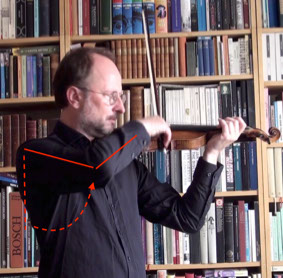
Ex. 3 Drawing the bow from the middle to the frog. The elbow joint closes and the arm pushes the bow into a triangular position.
The mechanism of in and out movements of the forearm, centred around the square position of the arm in the middle of the bow, is considered to be a crucial principle for sound production. The length of the modern bow allows a bow action which is proportionally divided, and coordinated between the joints of the arm. The motions from the middle of the bow to the tip are facilitated by the opening and closing of the elbow joint; the motions from the middle to the frog are controlled by the arm and shoulder joint.
The straight bow stroke from frog to tip is the foundation of the entire bowing technique. The chief problem in the straight bow stroke is to be found in the fact that the action in the form of a straight line does not come naturally to the members of the human body, [as] the bending of the joints causes circular motion to take place. (Galamian, 1962, p. 51)
The square position of the arm allows for the most efficient and flexible movements. Also, a bowing action at the middle, or just above the middle of the bow, affords the most resonant and springy response. ‘The control of the bow is easiest and most natural near the square position’ (Galamian, 1962, p. 52). That is why modern players use the square position in the most demanding virtuosic passages. The weight of the bow, being close to the middle, is ideally balanced, while the interaction between the joints of shoulder, elbow, forearm, wrist and fingers is in the most efficient constellation. The détaché bow strokes, consisting of small oscillating movements of the wrist, supported by the opening and closing of the elbow, result in a resonant sound but also allows for great speed.
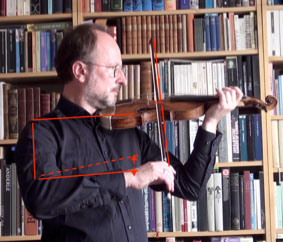
Ex. 4 Détaché bowing action with the modern bow. The square position of the arm coincides with the middle position of the bow, allowing for great efficiency in fast passages.
Vid. 1 Menuhin explaining the right way of bowing.
What is different with the baroque bow?
Applying the historical 'chin-off' hold of the violin, in combination with the use of the shorter baroque bow, entirely resets the relation between arm, elbow, wrist, and fingers. Forming the arm into a square position will place the baroque bow close to the tip (Ex. 5).
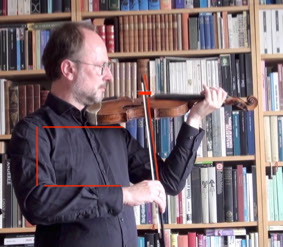
Ex. 5 Forming an ideal square position of the arm will place the baroque bow close to the tip.
There are two important consequences. Setting the bow on the string close to the tip will limit the opening trajectory of the elbow. The second consequence, for a sound producing movement, is that the ideal square position of the arm does not coincide with the ideal position of the bow in the middle. The bow set at the tip will lack its natural weight, requiring extra pressure of the arm and forefinger, which in turn dramatically alters the flexibility of the interaction between the joints of the arm.
Setting the baroque bow on the string in the middle of the bow will alter the angle of the arm from a square to a triangular position.
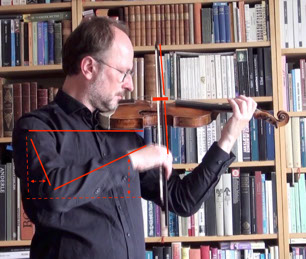
Ex. 6 Setting the baroque bow in the middle will alter the square position of the arm.
While the bow is now in the ideal position to use its natural kinetic properties to produce a resonant and flexible sound, the arm is not. The triangular angle of the arm does not facilitate the opening motion of the elbow. This puts most of the bow trajectory under the agency of the whole arm. To activate smaller movements, the wrist and fingers are employed. The central sound producing function in the modern bow action, based on the opening of the elbow in the middle of the bow, is thus distorted.
What conclusions can be drawn from these observations?
The modern bow has a longer, continuous, and more horizontal trajectory. Playing in any part of the bow, even short isolated patterns or quickly moving notes, always relates to the main trajectory. This is facilitated by the coordinated interaction of the joints, organized 'globally' throughout the whole length of the bow.
The trajectory of the baroque bow is shorter and not connected globally. Rhythmical patterns will be executed in hierarchically constructed combinations of longer and shorter bow strokes. Localized in kinaesthetic units, the larger arm movement, coinciding with larger metrical units, will trigger the consecutive movements of the wrist and fingers, that coincide with the articulatory and ornamental level of the metrical structure.
With these different characteristics in mind we can return to the questions at the beginning of this section. The modern bow is indeed 'singing', exploiting the total trajectory of the bow in a global, continuous, and horizontally driven motion of the arm. Opening the elbow outward from the body implies larger phrasing space, but also delegates the greater part of the responsibility for the sound production and phrasing to the bow action.
Rather than covering a large global space of the bow in a 'singing' mode, the baroque bow, lacking the 'traffic hub' of the square position obtained in the middle of the bow, affords more localized kinetic patterns that may be reminiscent of dance patterns, or the imitation of speech. The affinity to speaking and dancing is enhanced by the aesthetic ideals of the baroque period. In this respect, the seeming impediment of limited singing qualities is compensated by the articulatory qualities drawing on the imitation of speech and dance.
But claiming that the imitation of speech and dance are the articulatory affordances of the baroque bow, that are manifested in the resulting sound, will only distinguish the general difference between baroque and modern strategies of bowing. Looking at the baroque bow action through the lens of the Soundist vs. Gesturist dichotomy, in addition to the articulatory affordances, there are significant gestural implications. While the baroque bow operates in a trajectory with frequent vertical referential points, the bow action not only marks the musical structure sonically, but also, more importantly, triggers a kinaesthetic response in body movement. The shorter the bow trajectory, the more compensating body movements are necessary. The body movements are not employed only to support the sound production, but also to amplify, or even initiate, the gestures and dance movements.